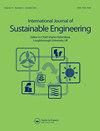The influence and analysis of urban spatial elements on national economic development
IF 3.6
Q3 GREEN & SUSTAINABLE SCIENCE & TECHNOLOGY
International Journal of Sustainable Engineering
Pub Date : 2022-04-04
DOI:10.1080/19397038.2022.2059590
引用次数: 0
Abstract
ABSTRACT Cities play an essential role in promoting the development of the whole national economy. Many scholars have proposed different methods to study this problem, but all have ignored the critical influence of network attention on the economy. Therefore, this study uses big Network data to profoundly analyse the relationship between urban spatial development and economic growth in eastern, central, and western China, further study this issue, and provide theoretical support for urban economic development. This study first divides China into three regions: eastern, central, and western, then selects the indicators of the national economy and urban development from 2014 to 2019, and finally constructs a panel regression model to explore the relationship between urban space elements and national economic development. The results show that China’s national economic development is closely related to spatial factors such as urban transportation, environment, science and technology, energy consumption, and housing price. These findings will help to make full use of the natural advantages of each region and guide the rational planning of the urban economy. This study provides references for urban development planning and industrial transfer in various regions of China and offers feasible suggestions for China’s overall national economic growth.城市空间要素对国民经济发展的影响与分析
城市在促进整个国民经济发展中发挥着至关重要的作用。许多学者提出了不同的方法来研究这一问题,但都忽视了网络注意力对经济的关键影响。因此,本研究利用大网络数据,深入分析了中国东部、中部和西部城市空间发展与经济增长的关系,进一步研究了这一问题,为城市经济发展提供了理论支持。本研究首先将中国划分为东部、中部和西部三个区域,然后选取2014-2019年国民经济和城市发展的指标,最后构建面板回归模型,探讨城市空间要素与国民经济发展的关系。研究结果表明,中国国民经济发展与城市交通、环境、科技、能源消耗、房价等空间因素密切相关。这些发现将有助于充分利用每个地区的自然优势,指导城市经济的合理规划。本研究为中国各地区的城市发展规划和产业转移提供了参考,并为中国整体国民经济增长提供了可行的建议。
本文章由计算机程序翻译,如有差异,请以英文原文为准。
求助全文
约1分钟内获得全文
求助全文
来源期刊

International Journal of Sustainable Engineering
GREEN & SUSTAINABLE SCIENCE & TECHNOLOGY-
CiteScore
7.70
自引率
0.00%
发文量
19
 求助内容:
求助内容: 应助结果提醒方式:
应助结果提醒方式:


